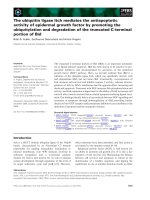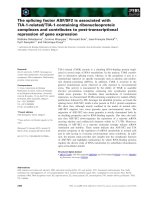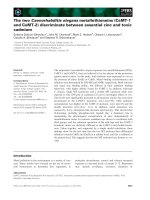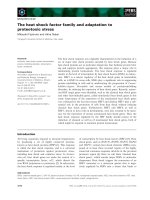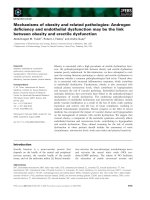Báo cáo khoa học: "The FrameNet Data and Software" ppt
Bạn đang xem bản rút gọn của tài liệu. Xem và tải ngay bản đầy đủ của tài liệu tại đây (30.95 KB, 4 trang )
The FrameNet Data and Software
Collin F. Baker
International Computer Science Institute
Berkeley, California, USA
Hiroaki Sato
Senshu University
Kawasaki, Japan
Abstract
The FrameNet project has developed a
lexical knowledge base providing a unique
level of detail as to the the possible syn-
tactic realizations of the specific seman-
tic roles evoked by each predicator, for
roughly 7,000 lexical units, on the ba-
sis of annotating more than 100,000 ex-
ample sentences extracted from corpora.
An interim version of the FrameNet data
was released in October, 2002 and is be-
ing widely used. A new, more portable
version of the FrameNet software is also
being made available to researchers else-
where, including the Spanish FrameNet
project.
This demo and poster will briefly ex-
plain the principles of Frame Semantics
and demonstrate the new unified tools for
lexicon building and annotation and also
FrameSQL, a search tool for finding pat-
terns in annotated sentences. We will dis-
cuss the content and format of the data re-
leases and how the software and data can
be used by other NLP researchers.
1 Introduction
FrameNet
1
(Fontenelle, 2003; Fillmore, 2002;
Baker et al., 1998) is a lexicographic research
project which aims to produce a lexicon contain-
ing very detailed information about the relation be-
1
framenet
tween the semantics and the syntax of predicators,
including verbs, nouns and adjectives, for a substan-
tial subset of English.
The basic unit of analysis is the semantic frame,
defined as a type of event or state and the partici-
pants and “props” associated with it, which we call
frame elements (FEs).
2
Frames range from highly
abstract to quite specific. An example of an abstract
frame would be the Replacement frame, with FEs
such as OLD and NEW as in the sentence Pat re-
placed [
Old
the curtains] [
New
with wooden blinds].
One sense of the verb replace is associated with
the Replacement frame, thus constituting one lexical
unit (LU), the basic unit of the FrameNet lexicon.
An example of a more specific frame is Ap-
ply
heat, with FEs such as COOK, FOOD, MEDIUM,
and DURATION. as in Boil [
Food
the rice] [
Duration
for 3 minutes] [
Medium
in water], then drain.
3
LUs
in Apply heat include char, fry, grill, and mi-
crowave, etc.
In our daily work, we define a frame and its
FEs, make lists of words that evoke the frame (its
LUs), extract example sentences containing these
LUs from corpora, and semi-automatically annotate
the parts of the sentences which are the realizations
of these FEs, including marking the phrase type (PT)
and grammatical function (GF). We can then auto-
matically create a report which constitutes a lexical
entry for this LU, detailing all the possible ways in
which these FEs can be syntactically realized. The
2
In similar approaches, these have been referred to as
schemas or scenarios, with their associated roles or slots.
3
In this sentence, as in most examples of boil in recipes,
the COOK is constructionally null-instantiated, because of the
imperative.
annotated sentences and lexical entries for approxi-
mately 7,000 LUs will be available on the FN web-
site and the data will be released by the end of Au-
gust in several formats.
2 Frame Semantics and FrameNet II
2.1 Frame Semantics in Theory and Practice
The development of the theory of Frame Semantics
began more than 25 years ago (Fillmore, 1976; Fill-
more, 1977), but since 1997, thanks to two NSF
grants
4
, we have been able to apply it in a serious
way to building a lexicon which we intend to be
both usable by human beings and machine-tractable,
so that it can serve as a lexical database for NLP,
computational lexical semantics, etc. In FrameNet
II, all the data, including the definitions of frames,
FEs, and LUs and all of the sentences and the an-
notation associated with them is stored in one rela-
tional database implemented in MySQL (Baker et
al., 2003; Fillmore et al., 2001).
The FrameNet public website contains an index
by frame and an index by LU which links to both
the lexical entry and the full annotation for each LU.
The frame-to-frame relations which are now being
entered in the database will be visible on the website
soon.
2.2 FrameNet II Data Release 1.0
The HTML version of the data consists of all the
files on the web site, so that users can set up a local
copy and browse it with any web browser. It is fairly
compact, less than 100 Mb in all.
The plain XML version of the data consists of the
following files:
frames.xml This file contains the descriptions of all
the 450 frames and their FEs, totaling more
than 3,000. Each frame also includes informa-
tion as to frame-to-frame relations.
luNNN.xml There is one such file per LU (roughly
7500) which contain the example sentences and
annotation (if any) for each LU.
4
We are grateful to the National Science Foundation for
funding the project through two grants, IRI #9618838 and
ITR/HCI #0086132. We refer to these two three-year stages
in the life of the project as FrameNet I and FrameNet II.
relations.xml A file containing information about
frame-to-frame and FE-to-FE relations and
meta-relations between them.
We intend to have a version of the XML that
includes RDF of the DAML+OIL flavor, so that
the FN frames and FEs can be related to existing
ontologies and Semantic Web-aware applications
can access FN data using a standard methodology.
Narayanan has created such a version for the FN I
data, and a new version reflecting the more complex
FN II data is under construction (Narayanan et al.,
2002).
3 The FrameNet Software Suite
3.1 The FrameNet Desktop tools
The FN software used for frame definition and an-
notation has been fundamentally rewritten since the
demo at the LREC conference last summer (Fill-
more et al., 2002a). The two major changes are (1)
combining the frame editing tools and the annotation
tools into a single GUI, making the interface more
intuitive and (2) moving to a client-server model.
In the previous version, each client accessed the
database directly, which made it very difficult to
avoid collisions between users, and meant that each
client was large, containing a lot of the logic of the
application, MySQL-specific queries, etc. In the
new version, the basic modules are now the MySQL
database, an application server, and one or more
client processes. This has a number of advantages:
(1) All the database calls are made by the server,
making it much easier to avoid conflicts between
users. (2) The application server contains nearly all
the logic, meaning that the clients are “thin” pro-
cesses, concerned mainly with the GUI. (3) The sep-
aration into client and server makes it easier to set up
remote access to the FN database. (4) The increased
overhead caused by the more complex architecture
is at least offset by the ability to cache frequently-
requested data on the server, making access much
faster.
The public FrameNet web pages contain static
versions of several reports drawn from the database,
notably, the lexical entry report, displaying all the
valences of each LU. The working environment for
the staff includes dynamic versions of these reports
and several others, all written as java applets. Par-
tially shared code makes these reports accessible
within the desktop package as well.
3.2 API, Library, and Utilities
We are currently working on defining a FN API
and writing libraries for accessing the database from
other programs. We plan to distribute a command-
line utility as a demonstration of this API.
4 FrameSQL and Kernel Dependency
Graphs
4.1 Searching with FrameSQL
Prof. Hiroaki Sato of Senshu University has written
a web-based tool which allows users to search ex-
isting FN annotations in a variety of ways. The tool
also makes conveniently available several other elec-
tronic resources such as WordNet, and other on-line
dictionaries. It is especially useful for doing conven-
tional lexicography.
4.2 Kernel Dependency Graphs
The major product of the project is the lexical
database of frame descriptions and annotated sen-
tences; although these clearly are potentially very
useful in many sorts of NLP task, FrameNet (at
least in its present phase) remains primarily lexi-
cographic. Nevertheless, as a an intermediate step
toward applications such as automatic text summa-
rization, we have recently begun studying kernel
dependency graphs (KDGs), which provide a sort
of automatic summarization of annotated sentences.
KDGs consist of
the predicator (verb, noun, or adjective),
the lexical heads of its dependents
the “marking” on the dependents (prepositions,
complementizers, etc. if any), and
the FEs of the dependents.
To take a simple example, (1-a), which is anno-
tated for the target chained in the Attaching frame,
could be represented as the KDG in (1-b).
(1) a. [
Agent
Four activists] chained [
Item
themselves] [
Goal
to an oil drilling rig
being towed to the Barents Sea] [
Time
in
early August].
b.
<KDG frame="Attaching" LU="chain.v">
<Agent>activists</Agent>
<Item>themselves</Item>
<Goal>to:oil\_drilling\_rig</Goal>
<Time>in:August</Time>
</KDG>
The situation can be complicated by the pres-
ence of higher control verbs and “transparent” nouns
which bring about a mismatch between the semantic
head and the syntactic head of an FE (Fillmore et al.,
2002b), as in (2), which should have the same KDG
as (1-a).
(2) [
Agent
Four activists] planned to chain [
Item
themselves] [
Goal
to the bottom of an oil
drilling rig being towed to the Barents Sea]
[
Time
in early August].
5 Layered Annotation and Frame
Semantic Parsing
A large majority of FEs are annotated with a triplet
of labels, one for the FE name, one for the phrase
type and one for the grammatical function of the
constituent with regard to the target. But the FN
software allows more than three layers of annotation
for a single target, for situations such as when one
FE contains another (e.g. in [
Agent
You] ’re hurting
[
Body
part
[
Victim
my] arms]).
In addition, the FN software allows us to annotate
more than one target in a sentence. A full represen-
tation of the meaning of a sentence can be built up
by composing the semantics of the frames evoked by
the major predicators.
6 Applications and Related Projects
In addition to the original lexicographic goal, a pre-
liminary version of our frame descriptions and the
set of more than 100,000 annotated sentences have
been released to more than 80 research groups in
more than 15 countries. The FN data is being used
for a variety of purposes, some of which we had
foreseen and others which we had not; these in-
clude uses as teaching materials for lexical seman-
tics classes, as a basis for developing multi-lingual
lexica, as an interlingua for machine translation, and
as training data for NLP systems that perform ques-
tion answering, information retrieval (Mohit and
Narayanan, 2003), and automatic semantic parsing
(Gildea and Jurafsky, 2002).
A number of scholars have expressed interest in
building FrameNets for other languages. Of these,
three have already begun work: In Spain, a team
from several universities, led by Prof. Carlos Subi-
rats of U A Barcelona, is building using their own
extraction software and the FrameNet desktop tools
to build a Spanish FrameNet (Subirats and Petruck,
forthcoming 2003) In
Saarbr¨ucken, Germany, work is proceeding on hand-
annotating a parsed corpus with FrameNet FE labels
(Erk et al., ). And in Japan, researchers from Keio
University and University of Tokyo are building a
Japanese FrameNet in the domains of motion and
communication, using a large newspaper corpus.
7 Contents of the Demo
We will demonstrate how the software can be used to
create a frame, create a frame element, create a lexi-
cal unit , define a set of rules for extracting example
sentences (and, optionally, marking FEs on them),
open an existing LU and annotate sentences, mark
an LU as finished, create a frame-to-frame relation,
and attach a semantic type to an FE or an LU.
We will demonstrate the reports available on the
internal web pages. We will show the complex
searches against the FrameNet data that can be run
using FrameSQL, including displaying the result-
ing sentences as KDGs. We will demonstrate how
frames can be composed to represent the meaning
of sentences using a (manual) frame semantic pars-
ing of a newspaper crime report as an example.
References
Collin F. Baker, Charles J. Fillmore, and John B. Lowe.
1998. The Berkeley FrameNet project. In ACL, ed-
itor, COLING-ACL ’98: Proceedings of the Confer-
ence, held at the University of Montr
´
eal, pages 86–90.
Association for Computational Linguistics.
Collin F. Baker, Charles J. Fillmore, and Beau Cronin.
2003. The structure of the FrameNet database. Inter-
national Journal of Lexicography.
K. Erk, A. Kowalski, and M. Pinkal. A corpus re-
source for lexical semantics. Submitted. Available
at erk/ OnlinePapers/ Lex-
Proj.ps.
Charles J. Fillmore, Charles Wooters, and Collin F.
Baker. 2001. Building a large lexical databank which
providesdeep semantics. In Benjamin Tsou and Olivia
Kwong, editors, Proceedings of the 15th Pacific Asia
Conference on Language, Information and Computa-
tion, Hong Kong.
Charles J. Fillmore, Collin F. Baker, and Hiroaki Sato.
2002a. The FrameNet database and software tools. In
Proceedings of the Third International Conference on
Languag Resources and Evaluation, volume IV, Las
Palmas. LREC.
Charles J. Fillmore, Collin F. Baker, and Hiroaki Sato.
2002b. Seeing arguments through transparent struc-
tures. In Proceedings of the Third International Con-
ference on Languag Resources and Evaluation, vol-
ume III, Las Palmas. LREC.
Charles J. Fillmore. 1976. Frame semantics and the na-
ture of language. In Annals of the New York Academy
of Sciences: Conference on the Origin and Develop-
ment of Language and Speech, volume 280, pages 20–
32.
Charles J. Fillmore. 1977. Scenes-and-frames seman-
tics. In Antonio Zampolli, editor, Linguistic Struc-
tures Processing, number 59 in Fundamental Studies
in Computer Science. North Holland Publishing.
Charles J. Fillmore. 2002. Linking sense to syntax in
FrameNet. In Proceedings of 19th International Con-
ference on Computational Linguistics, Taipei. COL-
ING.
Thierry Fontenelle, editor. 2003. International Journal
of Lexicography. Oxford University Press. (Special
issue devoted to FrameNet.).
Daniel Gildea and Daniel Jurafsky. 2002. Automatic la-
beling of semantic roles. Computational Linguistics,
28(3):245–288.
Behrang Mohit and Srinivas Narayanan. 2003. Seman-
tic extraction with wide-coverage lexical resources. In
Proceedings of the Human Language Technology Con-
ference (HLT-NAACL), Edmonton, Canada.
Srinivas Narayanan, Charles J. Fillmore, Collin F. Baker,
and Miriam R.L. Petruck. 2002. FrameNet meets the
semantic web: A DAML+OIL frame representation.
In Proceedings of the 18th National Conference on Ar-
tificial Intelligence, Edmonotn, Alberta. AAAI.
Carlos Subirats and Miriam R. L. Petruck. forthcoming
2003. The Spanish FrameNet project. In Proceedings
of the Seventeenth International Congress of Linguists,
Prague.



